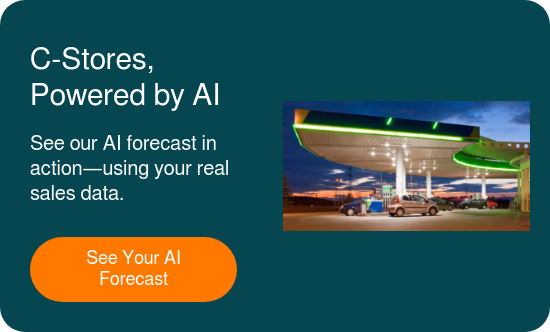Limited-time offers (LTOs) are critical to convenience store foodservice growth, but they’re notoriously hard to forecast. Upshop helps c-stores forecast LTOs more accurately using category-level modeling, global training, and flexible controls—without manual overrides or synthetic data.
Why LTOs Are a Growth Engine—and a Forecasting Headache
Convenience stores are leaning hard into foodservice, with LTOs driving traffic, loyalty, and margin. But launching a new item—especially one with a short shelf life—can create serious forecasting and execution challenges. Underproduce, and you miss sales. Overproduce, and you drive shrink.
Traditional methods like spreadsheet-based tracking, gut feel, and sales averages just aren’t enough to handle the variability of LTOs. These approaches often ignore category dynamics, local demand patterns, or operational constraints—making them risky and inefficient.
How AI Forecasting Makes the Difference
Upshop’s AI-driven platform is purpose-built for food retail complexity. When a new LTO hits your menu, here’s how the system works:
Category-Level Forecasting:
Even if the item is brand new, Upshop forecasts demand using performance of similar items within the same merchandising category (like deli sandwiches or salads).
Global Training:
For stores that haven’t sold the item before, the platform uses data from across the enterprise to model demand. No manual seeding of sales data is required.
Operational Controls:
Operators can further tailor forecasts using minimums, safety stock, waste thresholds, or forecast events (like a festival or weather surge).
These tools give operators the flexibility to maintain availability while limiting waste—especially critical for short-shelf-life food items.
Getting Smarter with Every Cycle
Because Upshop’s models learn from actual sales and adjust in real time, forecasting improves quickly. Some customers report LTO forecasts stabilizing in as little as 1–3 production cycles.
This helps teams respond fast and avoid both overproduction and out-of-stocks—even when testing new offers or expanding to new markets.
Beyond Forecasting: A Digitally Guided Store Team

Forecast accuracy only matters if your team can act on it.
That’s why Upshop’s platform connects forecasts directly to real-time store execution. Associates receive clear direction on what to prep, when to prep it, and how much to make—based on forecasted demand and shelf-life windows.
That guidance is especially valuable for:
- Part-time or seasonal workers
- Stores with rotating menus
- Operators launching frequent new products
By digitizing the mental math and guesswork, stores reduce execution risk and increase consistency across every shift.
Frequently Asked: How C-Stores Use AI for Foodservice
What if the store hasn’t sold the item before?
Upshop uses global training from other stores and items to forecast demand for the new offering—no sales history required.
Can it account for local events or traffic spikes?
Yes. Operators can set forecast events to raise or lower demand. The system also ingests weather and holiday data automatically.
How much IT or ops support is needed?
Not much. Core sales and item data is required, but most customers report low admin overhead after setup. The platform handles the rest.
LTOs Don’t Have To Be Hard
Limited-time offers are a key strategy for building foodservice credibility in convenience stores. But executing them at scale requires better tools.
Upshop’s AI grocery forecasting platform helps convenience retailers plan, produce, and sell confidently—without the risk and noise of manual guesswork.




